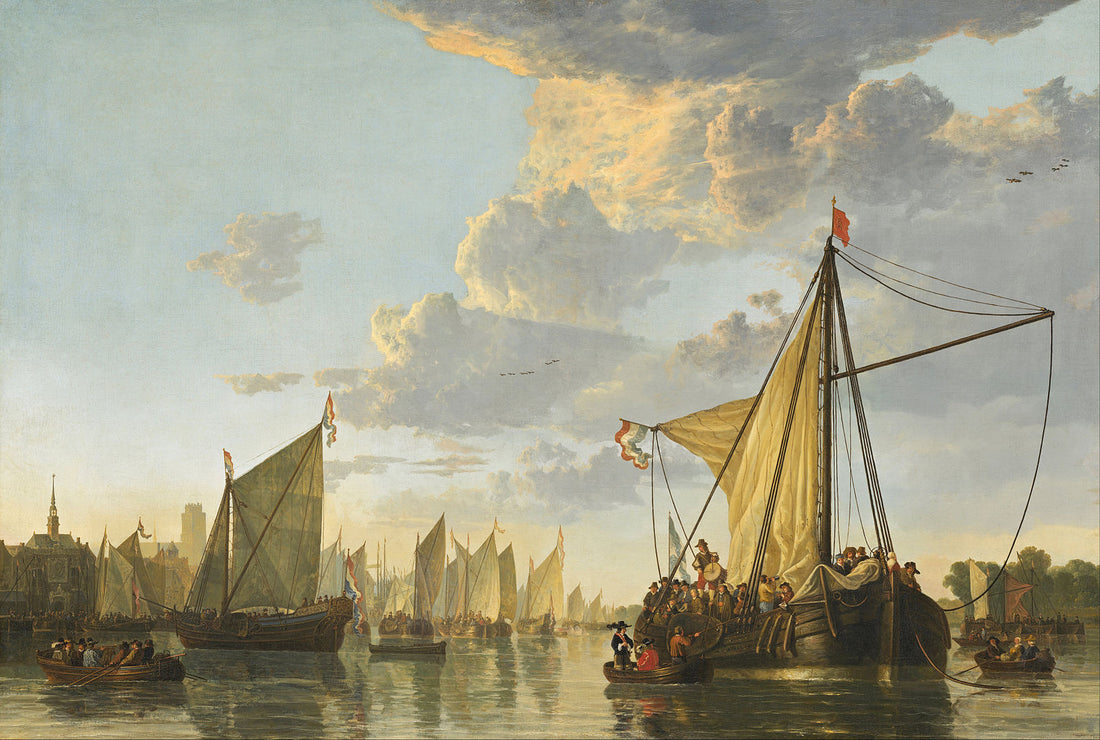
There is nothing -- absolutely nothing -- half so much worth doing as simply messing about in boats. In or out of 'em, it doesn't matter. Nothing seems really to matter, that's the charm of it. Whether you get away, or whether you don't; whether you arrive at your destination or whether you reach somewhere else, or whether you never get anywhere at all, you're always busy, and you never do anything in particular; and when you've done it there's always something else to do, and you can do it if you like, but you'd much better not.
—Kenneth Grahame (1988). “My Dearest Mouse: 'The Wind in the Willows' Letters”, Viking Press
Growing up on a small island in an apartment overlooking the Mediterranean sea and surrounded by works from my father’s art collection, a gravitation to seascapes I can clearly remember. Hauled into scenes where sail boats take prominence, we are struck by the mightiness and force projected as ships and their masts rock vigorously, leaving to the imagination their fate. Inside antique picture frames with ornate borders, sail boats glide on rivers and oceans: the longer we stand and fix our gaze, the further our minds are cast into dreams of nautical adventures which, for generations, have continued to enthrall and entertain. Naval wars, violent tempests, even seafaring pleasures, make for bountiful tales which still today, have viewers and listeners gather, leaning in closely to learn about the brave souls who took to the seas before them.

From the many ships represented in marine artworks on both still and tempestuous waters, some examples, such as Simon De Vlieger’s “Seascape in the morning (C.1640-1645) and Joseph Mallord William Turner’s “Fishing Boats with Hucksters Bargaining for Fish (1837- 1838) continue to haunt - their preferred mode of visitation: at hanging galleries and art Institutes around the world. Although at the time considered one of the lower genres after religious, portraits and scenes of everyday life, marine paintings were a popular focus for the Dutch Golden Age painters of the 17th Century. Some of the most famous among them- Hendrick Cornelisz Vroom credited as the founder of Dutch marine art, his later work conveying realistic depictions of the seas and detailed portraits of ships.

Aelbert Jacobszoon Cuyp whose masterful application of colour to depict golden skies in the early morning or late afternoon over ships at sea, would leave the onlooker in awe. Another, Salomon Van Ruysdael - a leading landscapist of his generation in the Baroque style who also produced river and estuary scenes. Such works influenced heavily British art for the next hundred years where, deriving from “a powerful Royal Navy” a strong national interest took hold supporting marine art and leading eventually, to the foundation of the Royal Society of Marine Artists in 1939. (mallgalleries.org.uk)
In the forefront of this trail of inspiration were father and son Van De Veldes. Contemporaries of Rembrandt, these were two of the most sought-after marine artists, known too for their connection to The Queen’s House over two decades “creating royal commissions, magnificent paintings and tapestries, as well as thousands of detailed sketches, drawings and designs.” (rmg.co.uk) Some of their best work, many of which representative of particular vessels and natural events, can be viewed in The National Maritime Museum at Greenwich.
Perhaps one of the most popular sub-genres of the nautical themes being represented during the 17th, 18th and indeed the 19th centuries were sea battles. Serving to capture historical facts as well as a means of the state propaganda, (arthive.com) these have been widely portrayed by various artists, two of the most notable - Charles Edward Dixon and James Hardy whose paintings such as those representing The Battle of Trafalgar leave a lasting impression following the viewer’s quiet study of magnified chaos and confusion.

Upon further interpretation, we might think to ourselves or be propelled to start a conversation about how we might have fared aboard a ship at sea. A stifling air like an arm stretching outwards to choke any life in the way of the cabins, odours sickeningly pungent, seeping through cupboards and kitchen sinks; the spread of disease ushered through by the sweat of hard graft. Some of this can be felt in the oil paintings of Anton Otto Fischer (1882- 1962) - illustrator for The Saturday Post who ran away to sea aged 16 and lived aboard a ship as a working sailor. It has been found Fischer’s particular affinity and talents were for nautical themes of sailing and the sea...these images covey energy and movement that perfectly assigned to an adventure narrative” (illustrationhistory.org) The artist also produced illustrations for Herman Melville’s 1891 novel Moby Dick or, The Whale as well as Robert Louis Stevenson’s Treasure Island among a few of his most notable.
Although the styles of paintings by seascape artists can vary greatly, emotions are transferred in similar ways luring us closer to the ship and it's sails of grace; the mood of the scene constantly shifting. Even on the smallest of canvasses for instance, where an artist takes on a birds-eye view through the medium of etching or photography, the details can be remarkably captivating.

Taking inspiration from the powers of the seas, marine artworks are a portal to history while lending to displays of other fascinating artefacts and collections. Today, these centuries-old pieces are held still, in high regard, sourced by art lovers, collectors and those with a keen eye for interior design. Positioned on walls and on shelves among other cherished findings whether for their connection to the sea or to compliment a particular style or colour-palette of a room. A visit to Cornwall some summers ago brought to light works by 19th and early 20th Century artists such as Cornish master Henry Scott Tuke and Welsh painter, illustrator, printmaker and photographer Frank Brangwyn (1867-1956.) With these and other discoveries of late, the hunt for framed seascapes on both familiar and unfamiliar shores continues.
